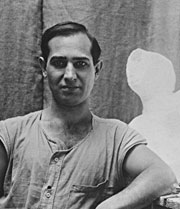He was born in Buenos Aires in 1899. He studied at the Academia Nacional de Bellas Artes. Man of very humble origin, he worked as a model for other sculptors. Alfredo Bigatti, with whom they shared an atelier, based himself upon Vitullo to perform his work La lucha. Bigatti urged him to go to Europe and, with little money raised by his companions, Vitullo embarked to Europe, as a sailor, in 1925.
In Paris he studied in detail the work of Rodin and Antoine Bourdelle, who hired him as a model in his atelier and taught him about sculpture and art in general, something Vitullo appreciated throughout the whole of his life.
He worked at quarries where he obtained the stone for his works and entered the Carver’s Corporation, a medieval origin union where he learned the technical secrets of direct carving.
He frequented Argentine artists such as Spilimbergo, Butler and Basaldúa, and the singer Carlos Gardel. He married Marie, a French woman.
Since 1934 he began sending his works to Parisian salons (des Indépendants, d’Automme) and in 1947 he performed his first individual exhibition at the Jean Boucher gallery.
Not long before he had become friends with the Dutch painter Bran Van Velde and with Antonin Artaud. In 1949 artist Nicolas de Staël attends his atelier to take sculpture lessons.
In 1950, doctor Ignacio Pirovano, a colleccionist and then the director of the National Museum of Decorative Arts in Buenos Aires, paid him a visit and became enthusiastic about Vitullo’s work. Due to the efforts of Pirovano, a retrospective exhibition of Vitullo’s works was organized at the National Museum of Modern Art in Paris. It opened in 1952.
Vitullo received official assignments from the Argentinean authorities in France, such as a General San Martín Monument that would be placed in Boulogne Sur Mer and a bust of Eva Perón for the Argentinean embassy in Paris. These works, both made in grey granite, the first one in 1950 and the second in 1952, represent each of the two approaches in Vitullo’s production. The San Martín monument is completely abstract; it consists of two superposed carved blocks, rather quadrangular, in which the prevailing horizontality reminds of sacrificial altars or of pre-Columbian echeloned pyramids. The work on Eva Perón is a figurative one, though the detachment from the real model endows the image with symbolic features, afar from the submissions imposed by portraits. The artist’s words make clear the sense of this work: “Eva Perón archetype symbol. Liberator of America’s oppressed races. I see her as a figurehead encircled with laurels.” This perhaps has originated the incomprehension of the Argentinean officers who hid the work for years at the embassy’s basement.
The prevailing subject in Vitullo’s work, in spite of his long, definitive estrangement from his country, deals with Argentina’s geography and its most typical cultures, such as the Indoamerican and the gaucho’s. This involves works like Gaucho (1937); the marble series performed for the Martín Fierro Monument between 1941 and 1945; Esfinge pampeana (Sphinx of the Pampas), El Río de la Plata y Cóndor, both from 1948; the Nahuel Huapi totem (1949), the Patagonia totem, Bagual or Gaucho in the pillory, Chola, the nine wood carvings ensemble for Viacrucis del gaucho (Gaucho’s Via Crucis) or Piedra tumbal a José Hernández (Tombstone for José Hernández), all from 1951; the totems Malambo and Cóndor and the granites La luna (The Moon) and Corazón de gaucho (Gaucho’s heart), from 1952.
Most of these works show a counterpoint between a prevailing horizontality in their stones, often referred to Argentina’s vast planes, and the verticality of the totems, which seem willing to surpass the strength of the land with their rising impulse. Both in his figurative works as well as in the abstract ones, Vitullo appeals to formal synthesis, to a faceting of planes stemming from cubism and to expressive deformation.
In 1969, a significant group of his works was repatriated, many of which were acquired to join the Buenos Aires Modern Art Museum’s collection.
